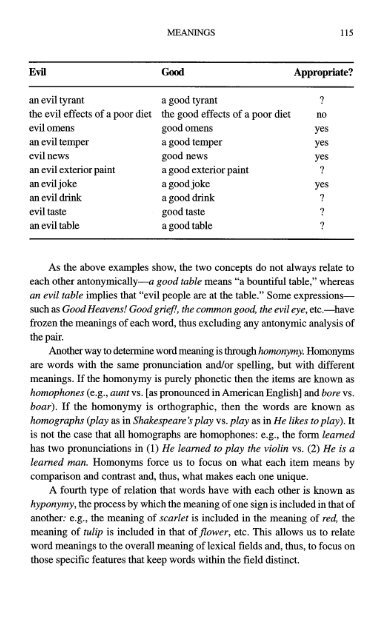A Basic Course in Anthropological Linguistics (Studies in Linguistic ...
A Basic Course in Anthropological Linguistics (Studies in Linguistic ...
A Basic Course in Anthropological Linguistics (Studies in Linguistic ...
You also want an ePaper? Increase the reach of your titles
YUMPU automatically turns print PDFs into web optimized ePapers that Google loves.
MEANINGS 115<br />
~~<br />
Evil Good Appropriate?<br />
an evil tyrant<br />
the evil effects of a poor diet<br />
evil omens<br />
an evil temper<br />
evil news<br />
an evil exterior pa<strong>in</strong>t<br />
an evil joke<br />
an evil dr<strong>in</strong>k<br />
evil taste<br />
an evil table<br />
a good tyrant<br />
the good effects of a poor diet<br />
good omens<br />
a good temper<br />
good news<br />
a good exterior pa<strong>in</strong>t<br />
a good joke<br />
a good dr<strong>in</strong>k<br />
good taste<br />
a good table<br />
As the above examples show, the two concepts do not always relate to<br />
each other antonymically-a good table means “a bountiful table,” whereas<br />
an evil table implies that “evil people are at the table.” Some expressions-<br />
such as Good Heavens! Good grie$f, the common good, the evil eye, etc.-have<br />
frozen the mean<strong>in</strong>gs of each word, thus exclud<strong>in</strong>g any antonymic analysis of<br />
the pair.<br />
Another way to determ<strong>in</strong>e word mean<strong>in</strong>g is through horrwnymy. Homonyms<br />
are words with the same pronunciation and/or spell<strong>in</strong>g, but with different<br />
mean<strong>in</strong>gs. If the homonymy is purely phonetic then the items are known as<br />
homophones (e.g., aunt vs. [as pronounced <strong>in</strong> American English] and bore vs.<br />
boar). If the homonymy is orthographic, then the words are known as<br />
homographs (play as <strong>in</strong> Shakespeare’s play vs. play as <strong>in</strong> He likes to play). It<br />
is not the case that all homographs are homophones: e.g., the form learned<br />
has two pronunciations <strong>in</strong> (1) He learned to play the viol<strong>in</strong> vs. (2) He is a<br />
learned man. Homonyms force us to focus on what each item means by<br />
comparison and contrast and, thus, what makes each one unique.<br />
A fourth type of relation that words have with each other is known as<br />
hyponymy, the process by which the mean<strong>in</strong>g of one sign is <strong>in</strong>cluded <strong>in</strong> that of<br />
another: e.g., the mean<strong>in</strong>g of scarlet is <strong>in</strong>cluded <strong>in</strong> the mean<strong>in</strong>g of red, the<br />
mean<strong>in</strong>g of tulip is <strong>in</strong>cluded <strong>in</strong> that offlower, etc. This allows us to relate<br />
word mean<strong>in</strong>gs to the overall mean<strong>in</strong>g of lexical fields and, thus, to focus on<br />
those specific features that keep words with<strong>in</strong> the field dist<strong>in</strong>ct.






